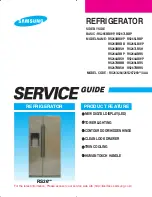
5
Style 2
1. Create a service loop (minimum diameter of 2 ft [61 cm]) with
the copper tubing. Avoid kinks when coiling the copper
tubing.
2. Remove the plastic cap from water valve inlet port. Place a
compression nut and sleeve on the copper tubing.
3. Insert the end of the copper tubing into the water valve inlet
port. Shape tubing slightly so that the tubing feeds straight
into the port to avoid kinks.
4. Slide the compression nut over the sleeve and screw into the
water valve inlet port.
5. Using an adjustable wrench, hold the nut on the plastic water
line to keep it from moving. Then, with a second wrench turn
the compression nut on the copper tubing counterclockwise
to completely tighten. Do not overtighten.
6. Check connection by pulling on copper tubing. Attach copper
tubing to refrigerator cabinet with a “P” clamp. Turn on water
supply to refrigerator and check for leaks. Correct any leaks.
Complete the Installation
1. Plug into a grounded 3 prong outlet.
NOTE: Allow 24 hours to produce the first batch of ice. Discard
the first three batches of ice produced. Allow 3 days to
completely fill the ice container.
Refrigerator Door(s) and Drawer
TOOLS NEEDED:
⁵⁄₁₆
",
³⁄₈
",
¹⁄₄
" hex-head socket wrench, a
#2 Phillips screwdriver, and a flat-blade screwdriver.
IMPORTANT:
■
Your refrigerator may have a standard reversible refrigerator
door (Style 1) with either a freezer door or freezer drawer, or
French doors (Style 2). Follow the instructions specific to the
door style of your model.
■
All graphics referenced in the following instructions are
included later in this section after “Final Steps.” The graphics
shown for the standard door (Style 1) are for a right-hand
swing refrigerator (hinges factory installed on the right).
■
If you only want to remove and replace the doors, see
“Remove Doors and Hinges” and “Replace Doors and
Hinges.”
■
Before you begin, turn the refrigerator control OFF, and
remove food and adjustable door or utility bins from the
doors.
Remove and Replace Refrigerator Door Handles
Style 1–Standard Door
Front Mount Handle
■
To remove the handle, remove the screw attaching the trim to
the upper end of the handle. Using a flat-blade screw driver
wrapped in masking tape, pry the trim piece from the lower
end of the handle. Then, remove the screws attaching the
handle to the door. See Front Mount graphic 2.
■
To replace handle, reverse directions.
Side Mount Handle
■
To remove the handle, remove the four screws attaching the
handle to the side of the door. See Side Mount graphic 2.
■
To replace the handle, align the holes in the handle with the
holes in the door. Then, insert a screw in the upper hole at
each end of the handle. Next, insert a screw in the lower
holes. Tighten the screws. See Side Mount graphic 2.
Style 2–French Doors
Metal Handles
■
Using a
³⁄₃₂
" Allen wrench, loosen the two set screws located
on the side of each handle. Pull the handle straight out from
the door. Make sure you keep the screws for reattaching the
handles. See Metal Handle graphic 1.
■
To replace the handles, reverse the directions.
Plastic Handles
■
To remove the handle, grasp the lower part of the handle
firmly, slide the handle up and pull the handle straight out
from the door. See Plastic Handle graphic 1.
■
To replace the handle, position the handle so that the large
holes in the mounting clips are down and align the holes with
the door studs. Rotate the handle so that the mounting clips
are flat against the door and slide the handle down to
engage. See Plastic Handle graphic 1.
A. Plastic water tubing
B. Sleeve
C. Compression nut
D. Copper tubing
A. Plastic water line
B. Water valve inlet port
C. Compression nut
D. Copper tubing
E. “P” clamp
B
A
C
D
B
A
C
D
E
Electrical Shock Hazard
Plug into a grounded 3 prong outlet.
Do not remove ground prong.
Do not use an adapter.
Do not use an extension cord.
Failure to follow these instructions can result in death,
fire, or electrical shock.
WARNING






































